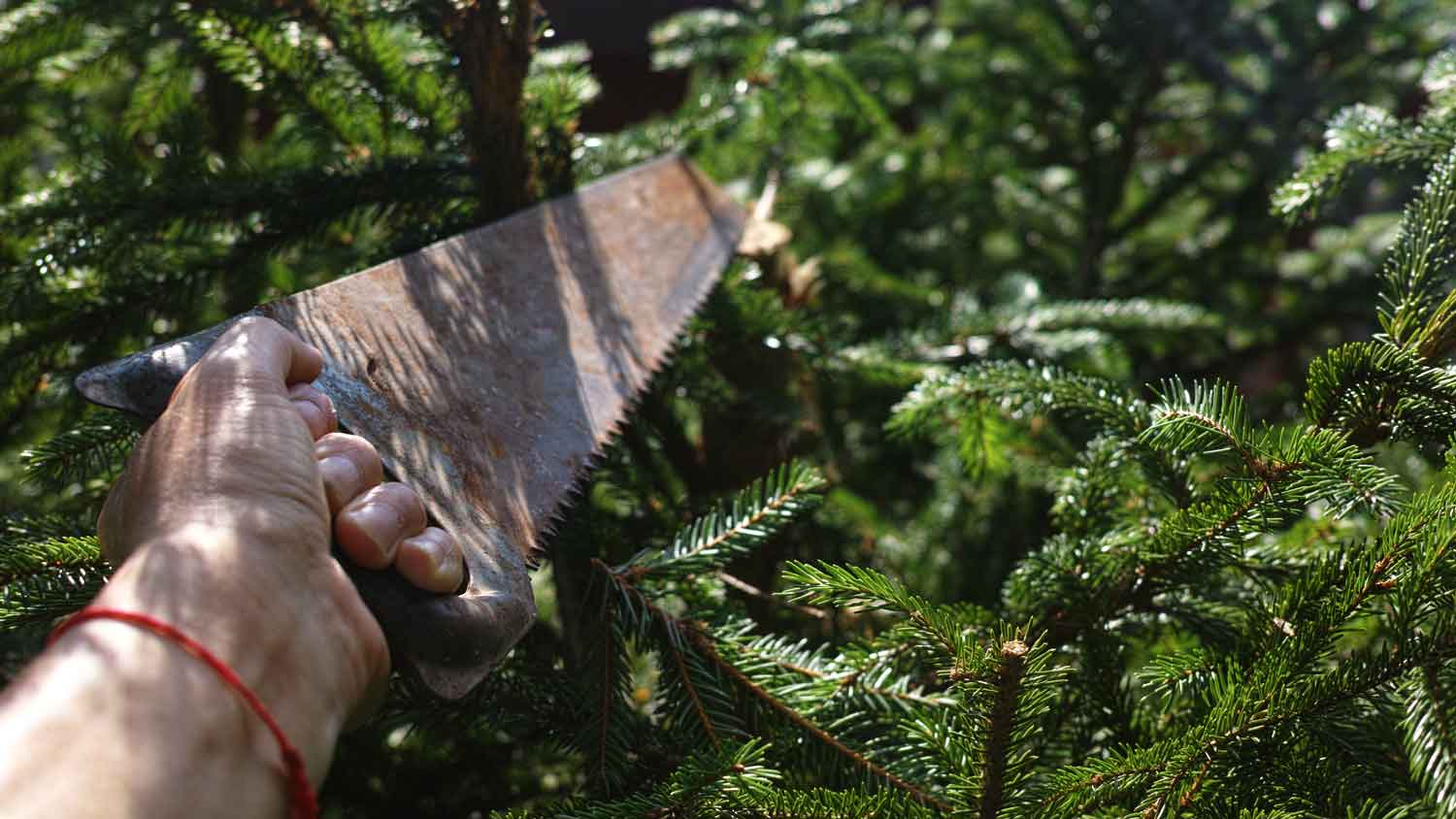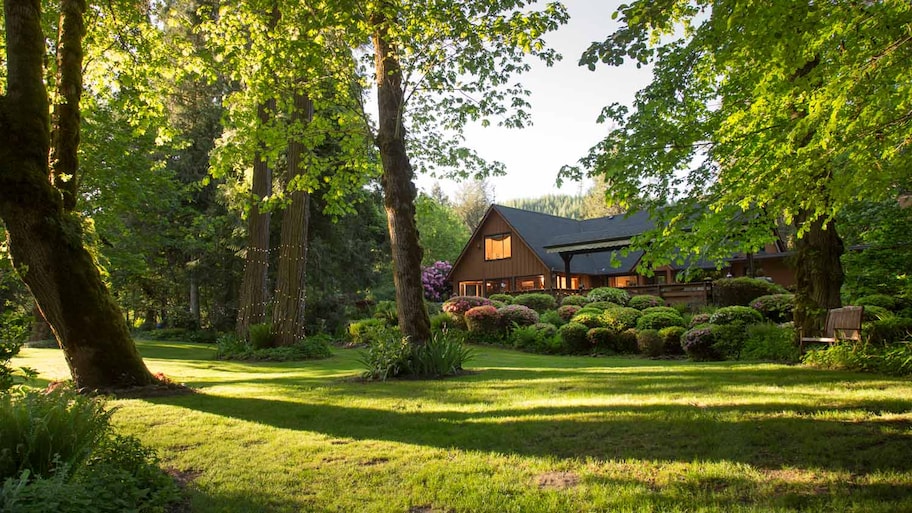The Best Time to Trim and Prune Trees for a Perfectly Sculpted Lawn
A little tree haircut goes a long way, but only if you do it the right way


Most arborists recommend trimming or pruning trees while they’re dormant.
In general, you’ll want to prune in late winter or early spring.
Prune flowering trees after they’ve already bloomed.
Avoid pruning saplings for the first year.
There are many reasons to prune your trees, but before you pull your shears out of the shed, take a look at your calendar. There is, in fact, an ideal time to start giving your trees a trim. It all depends on the time of year, the type of tree, and your overall goals. We’ll guide you on the best time to trim trees to take the guesswork out of yard work.
What Is the Difference Between Tree Pruning and Tree Trimming?
Tree pruning and tree trimming are often used interchangeably, especially because they’re two of the most common services offered by local tree services, and both involve removing branches. However, they both serve slightly different purposes.
Tree Pruning

Tree pruning is about tree health. During this process, you’ll remove parts of the plant that are detrimental to growth—like diseased or dead branches or overly thick branches that block light to the rest of the tree. This process helps promote stronger, healthier growth, while also shaping the plant. Basically, if your plant isn’t focusing on dragging literal dead weight, it can use its resources to push out new, lusher foliage.
Pruning is typically done every one to five years, though it's a good idea to—literally—nip dead or diseased foliage in the bud as you notice it. For most homeowners, tree pruning costs $175 to $2,650. The larger the tree, the more it costs.
Tree Trimming
Tree trimming is more about aesthetics. During this process, you’ll remove branches to help your tree maintain its size and shape (for example, artfully trimming a boxwood into a round topiary or removing a branch that’s growing dangerously close to a power line). Tree trimming is meant to remove healthy branches, but when it’s done right, it also helps the remaining foliage grow thicker and faster.
For most homeowners, tree trimming costs somewhere between $75 and $1,800. You generally won’t trim trees every year, but rather every few years as they start to grow out of shape.
Best Time to Trim Trees

Wondering when to trim a tree? Look no further than the cold weather. The best time to trim is almost always the winter—though there are a few exceptions. For most of the United States, trees are dormant between November and March. Cutting a dormant tree isn’t just easier (there’s no foliage to get in the way). It’s also healthier for the tree.
Trimming leaves an open wound which makes your tree vulnerable to insect infestation and disease. During the winter, there’s less disease transmission and fewer insects. It also happens to be the same time your tree takes its annual nap. Since it varies from tree to tree, call a tree trimming service near you to create the right plan for your yard.
Best Time to Prune Trees
You should lop off dead or dying foliage as you notice it cropping up, but the best time to prune a tree is typically when it’s dormant during winter or late spring. Most of the time, you’ll want to start snipping just a few weeks before your tree pops out of dormancy. Too early, and you’ll hurt the tree’s winter hardiness; too late, and you’ll cut off some of the blooms that would’ve otherwise grown.
Of course, this rule doesn’t apply to every tree. You should wait to prune certain flowering trees until after they bloom. Even if it’s not the ideal time, you may want to prune trees in the summer and early fall if they’re prone to bleeding sap. Remember that this may leave them vulnerable to insects and pathogens, but healthy mature trees generally bounce back fine.
When to Prune Trees by Tree Type
Though late winter or early spring is generally the best time to prune trees, that isn’t true for every towering tree. The sweet spot is typically when they’re still dormant, but there are still a few weeks before blooms appear.
Since different types of trees may have different ideal times, here’s a look at common types of trees and when it’s best to give them a snip.
| Tree Type | Time of Year |
|---|---|
| Apple trees | Late winter or early spring |
| Birch trees | Late summer or early autumn |
| Boxwood trees | Late winter or early spring |
| Cedar trees | Late winter or early spring |
| Fir trees | Late winter or early spring |
| Maple trees | Late winter or early spring |
| Oak trees | Late fall or winter |
| Pine trees | Late spring or early summer |
| Spruce trees | Late winter or early spring |
| Willow trees | Late winter or early spring |
Flowering Trees
You should prune flowering trees—like dogwood, magnolia, or crape myrtles—based on when and how they bloom. Some trees produce flowers on new wood (the growth you’ll get during the upcoming growing season). Other trees produce flowers on old wood (the growth you got during last year’s growing season). As a rule:
If your plant grows buds on new wood, prune it in late winter or early spring right before the growing season begins.
If your plant grows buds on old wood, prune it in late spring or early summer after it’s flowered.
If you cut old wood too early, you may accidentally remove next year’s blooms. To avoid that, make sure you cut them right after this season’s flowers fade.
Deciduous Trees
Deciduous trees—like oak or willow—shed their leaves before going dormant, and dormancy is typically the best time to prune them. Generally, you’ll want to wait until late fall or winter because the branches are easier to manage without their foliage and insects and diseases are less prevalent.
If you want to prevent bleeding, don’t wait until late winter. Some trees leak sap—or “bleed”—when leaving dormancy if they’ve recently been pruned. This process isn’t harmful, but many homeowners find it unsightly. Trees like birch are particularly susceptible, so you may want to prune it during a different season, like late summer or early autumn.
Evergreen Trees

Evergreen trees—like spruce and fir—don’t go dormant like deciduous trees, but their growth may slow down during the winter. For this reason, that’s generally the best time to prune. Prune your evergreens in late winter or early spring before growth picks back up. The exception is pine trees, which you should prune in late spring or early summer.
Sapling Trees
Young trees—or saplings—need time to establish themselves before you prune them. Once you’ve transplanted the tree into the ground, wait at least a year before you start cutting branches. It’s particularly important that you don’t remove the lower branches, since these protect the trunk. You can start pruning them as your tree begins to grow.
Mature Trees
Mature trees are more resilient than younger trees. In other words, they’ll give you a little leeway. Generally, you’ll want to prune a mature tree sometime between late fall through early spring when it’s dormant. The best time depends on the species.
Some species are more susceptible to disease, so don’t prune them during the active transmission period. For example, you should prune your oak tree in late fall or winter to prevent oak wilt. Since pruning can stress even a mature tree, prune strategically. Remove diseased branches as they appear and avoid pruning immediately after spring growth.
Fruit Trees
The best time to prune fruit trees is in late winter or early spring, right before they start growing new leaves. You can also prune water sprouts and diseased or dead branches in late summer, but do this sparingly since it can stress the tree. Avoid early winter altogether since this could impact the plant’s cold hardiness.
DIY Tree Trimming vs. Hiring a Pro

If you know about trees and gardening, there’s no problem pruning your trees on your own. It’s generally pretty straightforward for a small tree, provided you use the right tools and the proper technique. You’ll need pruning shears for branches less than 3/4 of an inch in diameter, loppers for branches up to 1.5 inches in diameter, and a handsaw for anything else.
That said, not all trees are so small. Sometimes, you’ll need a ladder, and other times, you’ll need special equipment like chainsaws and climbing equipment. Branches can be enormous and extremely heavy (think: a fully mature oak tree). It can be difficult—and even dangerous—to manage these types of trees alone. In this case, we’d strongly encourage you to hire a tree cutting service near you. A professional will:
Know the best time to prune each specific tree
Know which branches to remove for optimal growth
Safely remove dangerous branches
Know how to effectively trim and treat diseased trees
When trimming trees, it's essential to prioritize safety by maintaining a safe distance from power lines, avoiding the potential fall path, and wearing protective gear. We strongly recommend hiring a professional tree service to trim large trees, given the significant safety risks.
Having a pro prune or trim your tree generally costs between $75 and $1,800 per tree. However, if it is part of public property and encroaching on your property, the city may trim the tree for free.
Frequently Asked Questions
Trees that flower in the spring—like dogwood, cherry, magnolia, and pear—should not be pruned during the winter. These spring-flowering plants grow buds on old growth, so you’ll actually remove what would’ve been gorgeous flowering foliage. Instead, wait to prune until right after they bloom, when the flowers fade.
Generally, avoid trimming trees in the summer (with the exception of pruning fruit trees as needed). Trees use a lot of energy in the summer, most of which is relegated to new growth. If you chop it too early, you could stunt the next season's growth. Again, when in doubt, do some research based on the specific tree type.
It depends on the type of tree. Typically, late spring on the cusp of winter is ideal for trees about to emerge from dormancy and produce new buds. That said, late fall is ideal for certain deciduous trees prone to bleeding sap. Avoid trimming trees in early spring, when they’re prone to disease.
Though summer is not ideal, you can do some light pruning during this time of year. Just make sure it’s not excessive. Vigorous pruning will stress the tree and impact next year’s growth. Generally, August to September are the best summer-pruning months, particularly for fruit trees.
Pruning can impact cold hardiness—but it’s less about the exact temperature and more about temperature variation. Generally, you don’t want to prune trees when there’s a risk of temperatures suddenly dropping from 50 to 60 degrees Fahrenheit to 0 degrees Fahrenheit or below. A tree is most sensitive until 48 hours after it’s pruned.
















